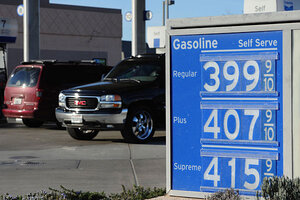Gas prices begin climb toward $4.50 a gallon, experts say
Gas prices could hit $4.50 a gallon nationwide by summer because of sanctions on Iran, a frigid winter in Europe, and logistical challenges in the US. The current all-time high is $4.11.

Chevron gas prices are displayed in Modesto, Calif., Wednesday.
Debbie Noda/The Modesto Bee/AP
New York
Many drivers are already grumbling at gas prices this winter. But by this summer, Friday's AAA average of $3.58 a gallon for regular gasoline may look downright attractive.
Some energy analysts think gasoline on a national basis could climb into the $4.50 a gallon range. That would be above the all-time peak of $4.11 a gallon set on July 14, 2008. In some states such as California, Hawaii, and Alaska, prices are normally higher and could get closer to $5 a gallon.
“We are on track for a very expensive summer,” says Sander Cohan, a gasoline-market analyst and principal at Energy Security Analysis, Inc. in Wakefield, Mass.
During the past two weeks, the price of crude oil on the international markets has risen by $7 a barrel to about $120 a barrel, in large part because of uncertainty over Iran, which has threatened to disrupt oil supplies because of a tightening financial noose around it.
“All that has to happen is for a tanker to hit a mine and the prices will be jumping,” says Mike Breard, an oil and gas analyst at Hodges Capital in Dallas. “A lot of people are afraid of oil rising to $140 a barrel.”
Every $1 rise in the price of oil ultimately results in an increase of 2.4 cents a gallon at the pump if the price stays up.
Last May, prices peaked at $3.97 a gallon after the price of gasoline rose 80 cents a gallon after February. That run-up was caused after the civil war in Libya reduced oil supplies and then flooding on the Mississippi River resulted in unexpected refinery outages.
To try to ameliorate the situation, President Obama released oil from the Strategic Petroleum Reserve.
If prices do rise this summer, Mr. Cohan says the causes are quite different and somewhat paradoxical. For example, because demand for gasoline has been low, two major refineries in the Philadelphia region have been shut-down, as has a large Hess oil refinery in the US Virgin Islands.
“A lot of supply has been turned off on the East Coast,” says Cohan. “East Coast refineries were just not competitive in a diminishing market.”
In the Midwest, however, there is plenty of oil because of growing production out of the Bakken formation in North Dakota and oil from Canada, says Mr. Breard. “There was so much oil some of it came down below $75 a barrel,” he says. “Now, it’s back up.”
One of the problems is moving that oil to the Gulf Coast where there is plenty of refining capability. A pipeline that used to move gasoline to the Midwest is now being converted to move unrefined oil the other direction. However, there will still be an need to move oil south, says Cohan.
“That’s what the Keystone XL pipeline was all about,” he says. “Bringing oil south, it eases congestion in the Midwest.”
Obama has blocked the pipeline for environmental reasons. On Friday, the House passed legislation to take away Obama’s authority on the pipeline, but the bill’s fate in the Senate was less certain.
Although there is plenty of refining capacity in the Gulf Coast, Cohan says the issue is getting gasoline to the East Coast markets, especially if demand revives this summer.
“You either have to use pipelines or tankers,” he says. “It really is a logistics problem more than anything else.”
In the past, refiners could turn to Europe to supply gasoline. However, this winter has been harsh for Europe and Russia. As a result, the price of oil originating from the North Sea (termed Brent crude), is now almost $20 a barrel higher than oil produced in the US. “So you will be paying higher prices no matter where you get it,” says Cohan.
Cohan worries that his forecast could prove too low if the US economy starts to grow faster or a hurricane shuts down Gulf Coast production. But, he says, “Right now we’re not ready to predict $5 a gallon gasoline.”

